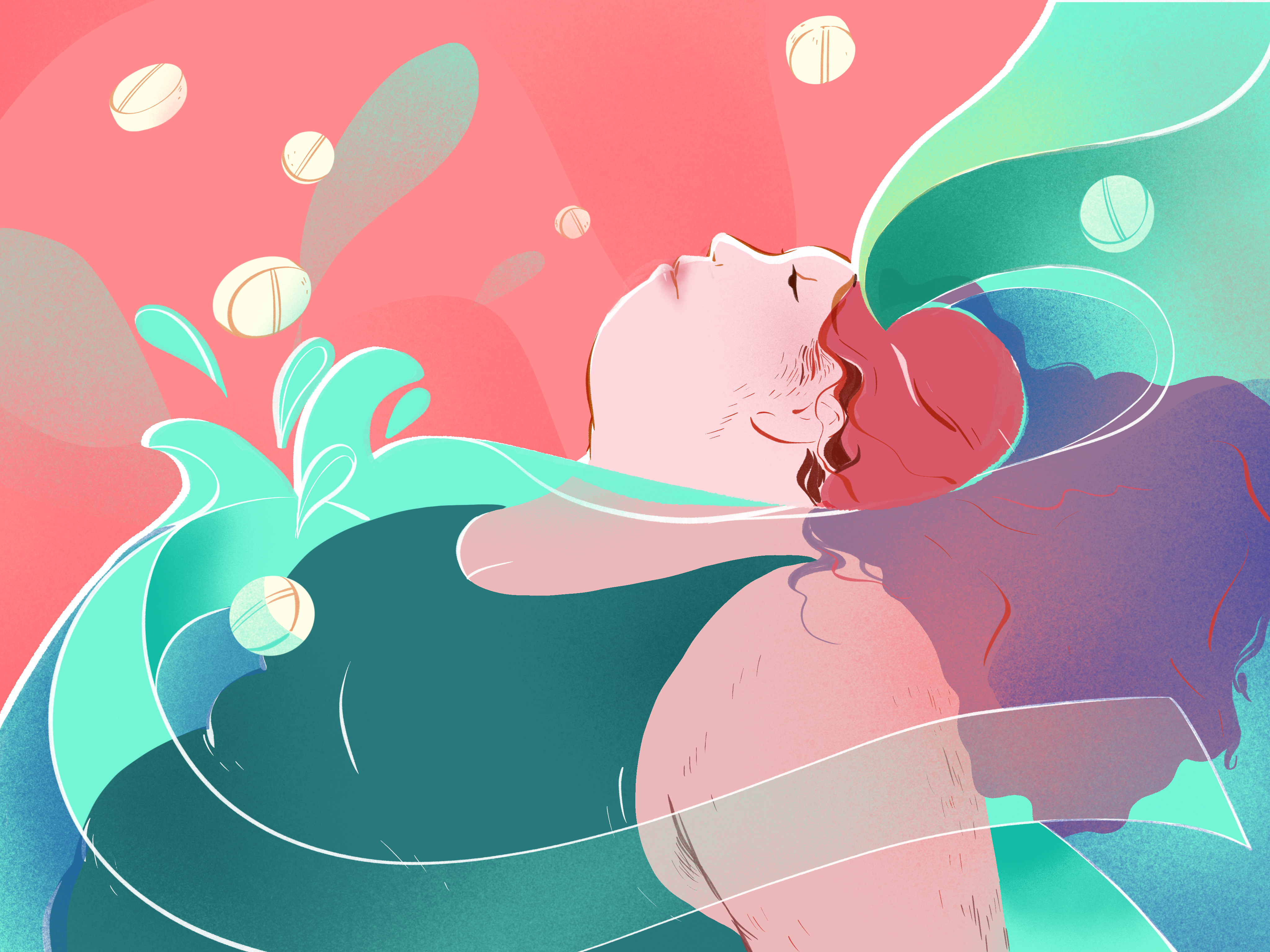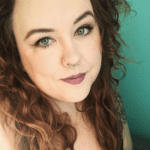When I hit puberty at 12, I thought my body was conspiring against me to make me as unattractive as possible. Not because of my boobs — those were great. It was the fuzzy shadow of brown, soft hair under my left eye, towards the outer corner and extending to my ear. From a distance it just looked like a shadow, or a makeup experiment gone awry. The patch grew with me into my teens, extending down my cheek until it hit my jawline and, eventually, continued under my chin. It became coarse and dark and entirely noticeable. Meanwhile, the other half of my face bloomed a cheek full of red, lumpy acne. By the time I was 14, I was shaving every morning. I was completely, utterly mortified. Adding to my distress was the weight that kept piling on. At first, it wasn’t a surprise: I had always been a chubby kid. But as I got older, my tummy grew rounder and my hips expanded. I started sizing out of my kid’s clothing until one day I came to class and was horrified to realize my Grade 6 teacher and I were wearing the same pair of Cotton Ginny cargo pants. By Grade 7, I was the biggest kid in my class and I was desperate to change. I cut carbs, fat and, eventually, food altogether —but nothing made a difference. My mom enrolled us both at Curves, the fitness chain targeted mostly toward middle-aged women. I would do the circuit of exercise machines and workouts with desperate enthusiasm, trying to accomplish more reps than the grey-haired women around me.
“By the time I was 14, I was shaving every morning. I was completely, utterly mortified.”
But my weight continued to climb and, along with it, dark patches of skin started to appear between my thighs, under my arms and on the back of my neck. Meanwhile, my insides were having their own whacky puberty party. My periods were swinging between total crampy bloodbath and disappearing for months on end. Eventually I convinced my mom to put me on hormonal birth control pills to regulate my cycle, but my other issues remained untamed. As a teenage girl, this was a total crisis. The following year, I learned that these weren’t weird bodily coincidences, but classic symptoms of polycystic ovary syndrome (PCOS). I was diagnosed while seeing my doctor for a prescription refill; she recognized the symptoms immediately, and they were later confirmed by an endocrinologist after a very uncomfortable ultrasound that no one warned me would take place inside my vagina. PCOS means I have excess “male” hormones, also known as androgens, along with follicles on my ovaries which can lead to pelvic or period pain and irregular periods. PCOS can also cause infertility and put people at a higher risk for certain cancers. Despite how common it is — up to 10 percent of women, by some estimates — there is no consensus on its cause. The condition is linked to higher weight, and, though people assigned female at birth naturally produce androgens, the excess causes acne, hair growth and insulin resistance. My family doctor told me to stay on birth control pills — a common treatment — and sent me on my way. As I became an adult, I faithfully took my pills; they kept my period consistent, but my other symptoms persisted. My face remained hairy despite dropping $2,000 on laser hair removal, my weight continued to increase as I yo-yo dieted and dermatologists could not crack the code of my acne. Then, at 23, two things happened: I came out as a lesbian and I stopped taking the pill.

I had an inkling that I was queer since I was a teenager, but it took getting out of a long relationship with man to finally admit I was gay. I was also growing weary of the pill — since coming out I no longer had pregnancy scares to worry about, and I correctly guessed that it wasn’t helping my mental state; many users have reported anxiety, depression and feelings of hopelessness while on it. I have bipolar II disorder, which is characterized by depressive lows and mild highs — getting off the pill certainly didn’t cure me, but it did seem to relieve the worst of my depressive symptoms. All of these things collided as I, an anxious baby dyke who was still both insecure about my sexuality and riding a post-pill emotional roller coaster, turned to Dr Google. I began searching things like “how to be sure you’re a lesbian” and “what causes lesbianism?” Google’s answer? PCOS. I found a study titled “Prevalence of polycystic ovaries and polycystic ovary syndrome in lesbian women compared with heterosexual women.” Between 2001 and 2003, a team of researchers looked at 618 women who sought fertility treatments at a UK clinic. Of the participants, 254 identified themselves as lesbians and 364 said they were straight. The results are pretty stark. Eighty percent of the lesbian women had polycystic ovaries, compared to 32 percent of the straight women who participated. Further, 38 percent of the lesbian women had PCOS, but only 14 percent of straight women did. And here’s the kicker — the lesbians with PCOS had higher levels of androgens than the straight women with the same syndrome. Read between the lines and it’s easy to draw a seemingly obvious conclusion — add “male” hormones to a woman, and you get a lesbian. In a press release for the study, Dr Rina Agrawal, then-deputy medical director at the London Women’s Clinic and The Hallam Medical Centre, was careful not to say that, though. “Our research neither suggests nor indicates that PCO/PCOS causes lesbianism, only that PCO/PCOS is more prevalent in lesbian women,” she said. “We do, however, hypothesize that hyperandrogenism, which is associated with PCOS, may be one of the factors contributing to the sexual orientation of women.” She also went on to underscore that treating PCOS shouldn’t be seen as a “cure” for lesbianism. Unfortunately, media outlets went on to regurgitate the study’s findings with little criticism from outside sources. “Scientists believe a biochemical imbalance associated with polycystic ovarian syndrome (PCOS) may contribute to the sexual orientation of women who are attracted to other women,” the Daily Mail said. “Research into a common ovarian disorder long known to be a cause of infertility may provide a scientific explanation for why some women are lesbians,” the Globe and Mail said. The study felt far from validating. Instead of shrugging it off as an interesting theory, it filled me with instant dread. Was I only gay because of my PCOS? The study sent my mind racing. Was I truly a lesbian, or was some quirk of my reproductive system making me like girls? Did quitting birth control pills awaken my inner lesbian beast? If I went back on them, would I like boys again? I added these frantic questions to my pile of anxious queries. This all, of course, points to a question that’s loomed so large over queer discourse that there’s a Lady Gaga song confirming it — are we born this way? As some in the anti-gay crowd have decided, we’re making a choice — an immoral, sinful choice — to be queer. We clapped back that no, baby, we are born this way — being queer is something innate, something in our genetic code. Researchers have dedicated a lot of time to this question, particularly since the 1990s, searching for whatever biological mechanism makes us swoon for same-sex matches. Early studies looked at our DNA, trying to find the so-called “gay gene.” A 1993 study claimed to identify such a marker, causing a big to-do, but that research has never been replicated and has ultimately been dismissed as a weak link, at best. But that doesn’t mean people stopped looking. In 2015, research was released that examined at cases of male twins where one twin was straight and the other was gay. Since twins share DNA, the idea was that something different in the gay twin’s genetic code could point to a preciptator for same-sex attraction. What they found is “epigenetic marks” that differed in nine places. Still, though, that doesn’t mean these differences are what caused one brother to be gay.
“Rather than help us better understand our queerness, these deep dives into hormone levels have been used against us.”
Other research has focused on hormones, playing on the idea that gay men are afflicted with too much female-ness, and that lesbians are afflicted with too much male-ness. Researchers have looked at things like fetal exposure to androgens. A study published in 2000 suggested that lesbians are exposed to higher androgen levels in-utero, as indicated by the lengths of their index and middle fingers. It also concluded that men are more likely to have an index finger shorter than their ring finger, which is also the case for lesbians. (That idea has now been distilled to articles like “8 Things Your Ring Finger Length Could Say About Your Personality” in Cosmopolitan magazine, which says you’re “more likely to be attracted to other women.”) Other studies have examined things like fraternal birth order, claiming that any son born after the eldest is likley to be gay. Yet another linked bisexuality to women taking progesterone while pregnant. Again, no study has been conclusive. As Dutch endocrinologist Louis Gooren phrased it in a review of some of these studies, “Imposing the model of femininity on male heterosexuals and of masculinity on lesbians has not led to new vistas.” Rather than help us better understand our queerness, these deep dives into hormone levels have been used against us — even in our professions. South African runner Caster Semenya, who has hyperandrogenism (a condition characterized by excess levels of “male” sex hormones such as testosterone) had to fight the highest sports judiciary body over her right to compete after new rules deemed her testosterone levels were to high for a female-identified athlete. (Back in 2009, Semenya was also subjected to “sex verification” testing and was then barred from competing for 11 months.) In 2015, Dutee Chand, a sprinter from India, won her case to be allowed to compete again after being indefinitely banned over her testosterone levels. And while male athletes are tested for synthetic hormones like steroids, it’s only women who have to go through hormone and chromosome tests, even though there’s no scientific proof that having more testosterone gives women an unfair competitive advantage. The idea that sexuality is determined by some sort of male-female on-off switch (a train of thought that typically ignores bisexual, pansexual and queer-identified people) gives homophobes and anti-LGBTQ2 individuals the false idea that biological precedence means queerness can be cured — or suppressed. This all plays into the assumptions homophobia is founded on in the first place: queer people are just doing gender wrong. This summer, the journal Science published an international study, the largest ever to look at the genetics of same-sex sexual behaviour. It found that genetics does play a role in same-sex attraction, but that sexual desire and behaviour is more complex than the function of a single “gay gene.” Two aspects of the study are worth noting: one, that researchers only studied cisgender white people of European descent; two, that several LGBTQ2 scientists have expressed concerns that the study’s finding could lead to harm and discrimination against queer and trans people. The study found that genetics, in myriad tiny ways, influences sexual orientation, but only to a degree — biology accounts for perhaps a third of our behaviour and desire, the New York Times recently reported. Beyond that, our environments and upbringings also help shape our sexual and romantic lives. The researchers concluded that DNA alone simply can’t predict sexual attraction. Basically, it’s what intuition has always told me: it’s complicated.

The PCOS study haunted me as I came into my queerness; it was always in the back of my mind, even as I started to view my sexuality as a gift instead of a burden. By my late 20s, I felt more comfortable in my skin but still feared that a date would graze my face and feel stubble, reminding us both that I wasn’t whole, that my hormones were not adequately female. I worried that my queerness was literally an illness, caused by a syndrome I had no control over. A fake lesbian. An unnatural lesbian. A poser. Thankfully I’ve learned a thing or two about scientific literacy, due in part to a stint in health reporting. Last winter, I was researching metformin, a medication to treat type 2 diabetes that can also help women with PCOS. My periods, by that point, had dried up completely and I was looking for a solution that didn’t involve hormonal birth control. As I scoured PCOS message boards, I came across that lesbian study from the UK again. I reread it, but this time with a critical eye. I found that its linking of PCOS to lesbianism wasn’t actually that great of a hypothesis to begin with. The sample size — 618 women, 254 of which were lesbians — isn’t very compelling when you consider that these women were already seeking fertility treatment. It could be that lesbians are more likely to seek fertility treatment, which seems very possible considering pregnancy for lesbian couples is a lot trickier than for straight couples. In 2008, another study was published (granted, using a smaller sample) that found no difference in PCOS between lesbians and straight women.
“Pointing to a ‘cause’ for homosexuality may have, at one point, been a useful tool to counter homophobic rhetoric, but what good is it doing us now?”
It’s shocking how little knowledge doctors have of a syndrome that affects such a large number of women. On the other hand, what information that does exist certainly hasn’t helped me. To hear over and over that PCOS is a result of “male” hormones, that my inner workings aren’t sufficiently female, only served to make me feel more abnormal at times when I was struggling to feel okay as a young woman, and then as a lesbian. Maybe if the world was kinder to women who don’t embody stereotypical femininity, and wasn’t so focused on us removing every inch of our hair (facial or otherwise), this would all be easier. If anything, I found solace in the queer world, where hair, hormones and gender identity have infinite, valid combinations. Pointing to a “cause” for homosexuality may have, at one point, been a useful tool to counter homophobic rhetoric, but what good is it doing us now? We know there isn’t just gay and straight in the world, but a whole host of sexual and gender identities. And we should also know by now that people who hate queers aren’t going to stop just because we finally discover a rainbow in someone’s DNA. Instead, it could go the other way: at the time, the “gay gene” discovery was controversial because it suggested that we could screen for queerness in fetuses and abort the undesirable, or put kids into abusive therapy because they tested positive. There will never be enough scientific studies to defeat homophobia. I’m now freshly into my 30s and my hormones remain unruly. I take a daily metformin, which has restored my periods, but I still have to attend to unwanted hair and my body is still firmly, lusciously fat. The difference now is that I don’t see these things as a failure — of my femininity, gender or body — but as a simple fact of life. I live, I breathe, I shave. It’s okay. I remember the moment I finally let myself ask out loud, “What if I’m a lesbian?” I was alone in my room, and I froze, my blood buzzing with excitement. It was like my body already knew the truth — it was just waiting for my brain to get there. I do think queerness is innate, if for no other reason than that I feel it in my bones. But even if it isn’t biological, even if somehow people simply choose to be gay, I don’t care, in the same way that I don’t care if some doctor somewhere thinks my PCOS is what made me a lesbian. I just want to move through the world safely, to feel comfortable in my identity and for my girlfriend to stop accidentally misplacing my razor. Please, babe, I need it for my face.
Line break image by rambo182/DigitalVision Vectors/Getty Images Plus


 Why you can trust Xtra
Why you can trust Xtra


